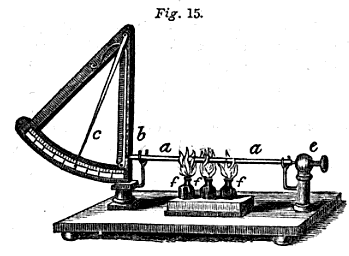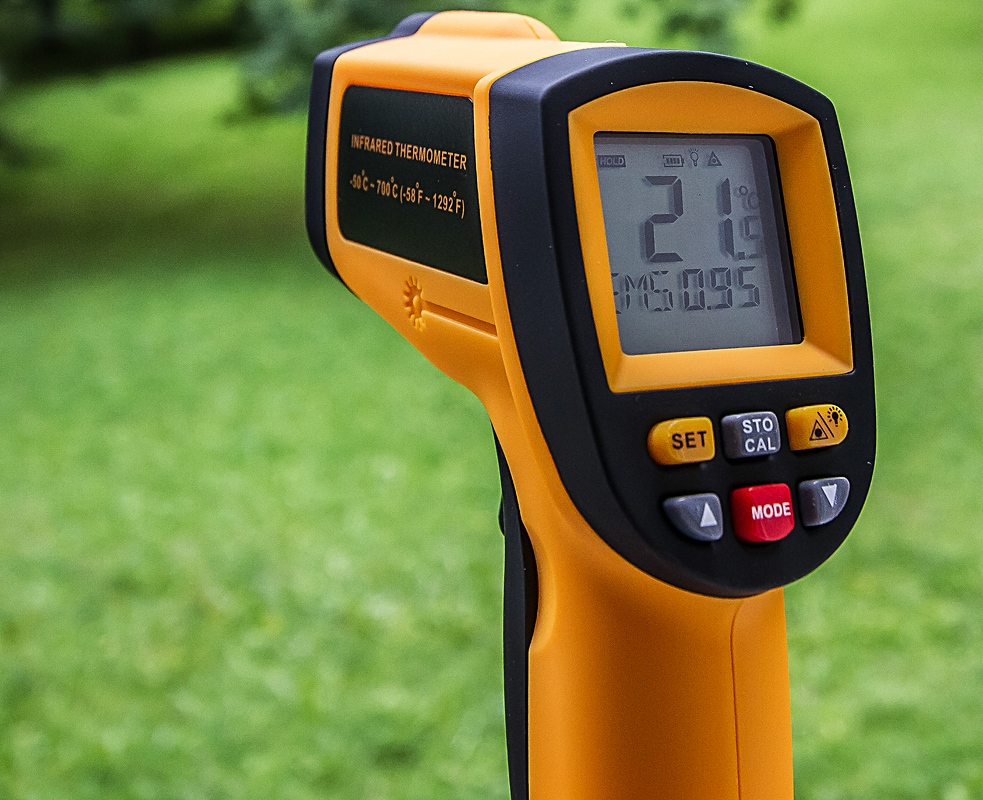|
Aethrioscope
An aethrioscope (or æthrioscope) is a meteorological device invented by Sir John Leslie in 1818 for measuring the chilling effect of a clear sky. The name is from the Greek word for clear – ''αίθριος''. It consists of a metallic cup standing upon a tall hollow pedestal, with a differential thermometer placed so that one of its bulbs is in the focus of the paraboloid formed by the cavity of the cup. The interior of the cup is highly polished and is kept covered by a plate of metal, being opened when an observation is made. The second bulb is always screened from the sky and so is not affected by the radiative effect of the clear sky, the action of which is concentrated upon the first bulb. The contraction of the air in the second bulb by its sudden exposure to a clear sky causes the liquid in the stem to rise. The device will respond in a contrary fashion when exposed to heat radiation and so may be used as a pyrometer A pyrometer is a type of remote-sensing thermo ... [...More Info...] [...Related Items...] OR: [Wikipedia] [Google] [Baidu] |
Aethrioscope
An aethrioscope (or æthrioscope) is a meteorological device invented by Sir John Leslie in 1818 for measuring the chilling effect of a clear sky. The name is from the Greek word for clear – ''αίθριος''. It consists of a metallic cup standing upon a tall hollow pedestal, with a differential thermometer placed so that one of its bulbs is in the focus of the paraboloid formed by the cavity of the cup. The interior of the cup is highly polished and is kept covered by a plate of metal, being opened when an observation is made. The second bulb is always screened from the sky and so is not affected by the radiative effect of the clear sky, the action of which is concentrated upon the first bulb. The contraction of the air in the second bulb by its sudden exposure to a clear sky causes the liquid in the stem to rise. The device will respond in a contrary fashion when exposed to heat radiation and so may be used as a pyrometer A pyrometer is a type of remote-sensing thermo ... [...More Info...] [...Related Items...] OR: [Wikipedia] [Google] [Baidu] |
Pyrometer
A pyrometer is a type of remote-sensing thermometer used to measure the temperature of distant objects. Various forms of pyrometers have historically existed. In the modern usage, it is a device that from a distance determines the temperature of a surface from the amount of the thermal radiation it emits, a process known as pyrometry and sometimes radiometry. The word pyrometer comes from the Greek word for fire, "πῦρ" (''pyr''), and ''meter'', meaning to measure. The word pyrometer was originally coined to denote a device capable of measuring the temperature of an object by its incandescence, visible light emitted by a body which is at least red-hot. Modern pyrometers or infrared thermometers also measure the temperature of cooler objects, down to room temperature, by detecting their infrared radiation flux. Principle It is based on the principle that the intensity of light received by the observer depends upon distance of observer from source and temperature of dis ... [...More Info...] [...Related Items...] OR: [Wikipedia] [Google] [Baidu] |
John Leslie (physicist)
Sir John Leslie, FRSE KH (10 April 1766 – 3 November 1832) was a Scottish mathematician and physicist best remembered for his research into heat. Leslie gave the first modern account of capillary action in 1802 and froze water using an air-pump in 1810, the first artificial production of ice. In 1804, he experimented with radiant heat using a cubical vessel filled with boiling water. One side of the cube is composed of highly polished metal, two of dull metal (copper) and one side painted black. He showed that radiation was greatest from the black side and negligible from the polished side. The apparatus is known as a Leslie cube. Early life Leslie was born the son of Robert Leslie, a joiner and cabinetmaker, and his wife Anne Carstairs, in Largo in Fife. He received his early education there and at Leven. In his thirteenth year, encouraged by friends who had even then remarked his aptitude for mathematical and physical science, he entered the University of St Andrews. O ... [...More Info...] [...Related Items...] OR: [Wikipedia] [Google] [Baidu] |
Longmans, Green & Co
Longman, also known as Pearson Longman, is a publishing company founded in London, England, in 1724 and is owned by Pearson PLC. Since 1968, Longman has been used primarily as an imprint by Pearson's Schools business. The Longman brand is also used for the Longman Schools in China and the ''Longman Dictionary''. History Beginnings The Longman company was founded by Thomas Longman (1699 – 18 June 1755), the son of Ezekiel Longman (died 1708), a gentleman of Bristol. Thomas was apprenticed in 1716 to John Osborn, a London bookseller, and at the expiration of his apprenticeship married Osborn's daughter. In August 1724, he purchased the stock and household goods of William Taylor, the first publisher of ''Robinson Crusoe'', for 9s 6d. Taylor's two shops in Paternoster Row, London, were known respectively as the ''Black Swan'' and the ''Ship'', premises at that time having signs rather than numbers, and became the publishing house premises. Longman entered into partn ... [...More Info...] [...Related Items...] OR: [Wikipedia] [Google] [Baidu] |
Thermometer
A thermometer is a device that temperature measurement, measures temperature or a temperature gradient (the degree of hotness or coldness of an object). A thermometer has two important elements: (1) a temperature sensor (e.g. the bulb of a mercury-in-glass thermometer or the pyrometric sensor in an infrared thermometer) in which some change occurs with a change in temperature; and (2) some means of converting this change into a numerical value (e.g. the visible scale that is marked on a mercury-in-glass thermometer or the digital readout on an infrared model). Thermometers are widely used in technology and industry to monitor processes, in meteorology, in medicine, and in scientific research. History While an individual thermometer is able to measure degrees of hotness, the readings on two thermometers cannot be compared unless they conform to an agreed scale. Today there is an absolute thermodynamic temperature scale. Internationally agreed temperature scales are designed to ... [...More Info...] [...Related Items...] OR: [Wikipedia] [Google] [Baidu] |
Thermometers
A thermometer is a device that measures temperature or a temperature gradient (the degree of hotness or coldness of an object). A thermometer has two important elements: (1) a temperature sensor (e.g. the bulb of a mercury-in-glass thermometer or the pyrometric sensor in an infrared thermometer) in which some change occurs with a change in temperature; and (2) some means of converting this change into a numerical value (e.g. the visible scale that is marked on a mercury-in-glass thermometer or the digital readout on an infrared model). Thermometers are widely used in technology and industry to monitor processes, in meteorology, in medicine, and in scientific research. History While an individual thermometer is able to measure degrees of hotness, the readings on two thermometers cannot be compared unless they conform to an agreed scale. Today there is an absolute thermodynamic temperature scale. Internationally agreed temperature scales are designed to approximate this close ... [...More Info...] [...Related Items...] OR: [Wikipedia] [Google] [Baidu] |
1818 In Scotland
Events from the year 1818 in Scotland. Incumbents Law officers * Lord Advocate – Alexander Maconochie * Solicitor General for Scotland – James Wedderburn Judiciary * Lord President of the Court of Session – Lord Granton * Lord Justice General – The Duke of Montrose * Lord Justice Clerk – Lord Boyle Events * 13 January – Torgoyle Bridge in Glenmoriston is swept away by an exceptional flood event. * 4 February – the Honours of Scotland are put on display in Edinburgh Castle after being discovered in store there; Walter Scott, one of the prime movers in the discovery, is rewarded with a baronetcy in 1820. * 17 February – the remains of King Robert the Bruce found at Dunfermline Abbey. * 3 March – construction of the Union Canal begins at the Edinburgh end. * 19 March – Church of St John the Evangelist, Edinburgh, designed by William Burn, dedicated. * Mid-May – paddle steamer ''Thames'' makes the first steamboat passage from the Clyde to Du ... [...More Info...] [...Related Items...] OR: [Wikipedia] [Google] [Baidu] |
1818 In Science
The year 1818 in science and technology involved some significant events, listed below. Astronomy * January 3 (21:52 UTC) – Venus occults Jupiter, last occultation of one planet by another before 22 November 2065. Chemistry * Pierre Joseph Pelletier and Joseph Bienaimé Caventou isolate the alkaloid strychnine in Paris. * Louis Jacques Thénard discovers hydrogen peroxide. Exploration * John Ross sets sail in search of the Northwest Passage. Medicine * September 25 – In London, Dr James Blundell carries out the first blood transfusion using human blood. * Jean Esquirol produces reports urging greater medicalization in the treatment of insanity in France. * Carl Ferdinand von Graefe publishes his pioneering work on rhinoplasty, ''Rhinoplastik''. Meteorology * Luke Howard begins publication of ''The Climate of London'', the first book on urban climatology in English, presenting new thinking on atmospheric electricity and the causes of precipitation. * Alexander Adie pa ... [...More Info...] [...Related Items...] OR: [Wikipedia] [Google] [Baidu] |
Atmospheric Physics
Within the atmospheric sciences, atmospheric physics is the application of physics to the study of the atmosphere. Atmospheric physicists attempt to model Earth's atmosphere and the atmospheres of the other planets using fluid flow equations, chemical models, radiation budget, and energy transfer processes in the atmosphere (as well as how these tie into boundary systems such as the oceans). In order to model weather systems, atmospheric physicists employ elements of scattering theory, wave propagation models, cloud physics, statistical mechanics and spatial statistics which are highly mathematical and related to physics. It has close links to meteorology and climatology and also covers the design and construction of instruments for studying the atmosphere and the interpretation of the data they provide, including remote sensing instruments. At the dawn of the space age and the introduction of sounding rockets, aeronomy became a subdiscipline concerning the upper layers of the atmo ... [...More Info...] [...Related Items...] OR: [Wikipedia] [Google] [Baidu] |




